

It’s not everyday a guy in Switzerland comes into contact with tea. How did you become interested in tea ceremony? Why did you decide to come to Kyoto?
Sōzui: When I was living in Switzerland, I practiced martial arts. You might have heard of aikido? This was my first contact with Japanese culture. I was fortunate to have a teacher who introduced me to the Japanese concept, bun bu ryo do. The idea martial arts and cultural arts should go together, in a parallel way. One should study a cultural art, alongside a martial art, to balance off the aggressive side with a softer side. My teacher encouraged us to study a cultural art and this is why I started studying tea, to balance out my martial arts practice.
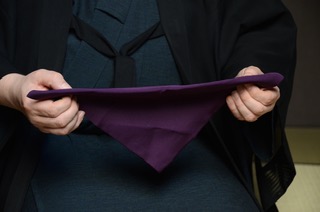
I happened to meet a Japanese lady living in Zurich who was married to a Swiss fellow. She was teaching tea out of her apartment and I studied with her. While studying with her, I started to get more interested in tea and wanted to study in Japan. Luckily, I was accepted as an in-house student at the headquarters of Urasenke Tea School in Kyoto where I’ve lived in Japan for the past 20 years.
I’ve talked with many visitors to Japan and Japanese people. Their image of Japanese tea is that it’s very strict and there are so many rules. What do you think about this?
Sōzui: When you first come into contact with tea, it feels as if there are lots of rules. The movements are very precise. The way you open the door, the amount of steps you take on a tatami mat is given, where you place the objects on the mat is measured to the exact line, making it crucial to study the precision of movements and other necessary details. But in the end, all of those points and rules are not that important. They’re meant to point you up the “tea mountain” and help you find the top because if you don’t know the mountain, you’ll get lost on the way, so the rules create a path.
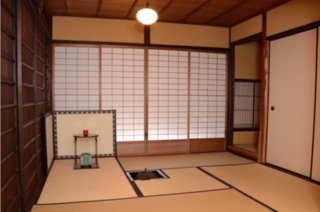
Between the rules though, there is a lot of freedom and space to find your own style, preferences and approach to tea. Like I said though, you need rules to help give you a framework. Similar to painting, you need a frame or canvass otherwise you can’t work. But once you have an established framework, this allows you to bring in your own creativity and learn how to use different brushes and painting styles to create a beautiful painting. In tea, we use the framework to create a beautiful and enjoyable tea gathering for our guests.
Besides the rules, in tea ceremony there are many other elements. You have garden design, house design, calligraphy, flower arrangement, you learn how to cook-kaiseki, pottery, woodwork, bamboo work, metal work, lacquerware, and study about history and philosophy. All of these elements come together in the tearoom. Naturally you’re exposed to beautiful pieces and part of the pleasure in being in the tearoom is to touch and connect with all of these pieces of art. It’s very different from a museum where you’re not allowed to actually touch anything, just look. In the tearoom you have direct contact with all of these art forms and pieces, seeing them up close and touching them with your own hands and this is a very unique way to surround yourself with beauty. Here there is an intersection of beauty, creativity and art within a precise framework. For me the rules never felt restrictive. Quite the opposite, allowing you a degree of freedom to discover your own creativity within the framework.

It seems there are so many elements in tea but they all revolve around the idea of a tea ceremony. What would an actual tea ceremony look like? On what occasions would you hold a tea ceremony?
Sōzui: That’s a good question. Actually, in Japanese the concept of “tea ceremony” doesn’t exist. That’s a Western concept. When Westerners first saw it they felt it was kind of like a ceremony and simply labeled it as such. In Japanese, a formal tea gathering is called chaji.
When do you do it? Well, any excuse is a good one but usually you’d have one on special occasions, for example a friend who is getting married, celebrating a birthday or it could be a memorial service.
How does it look? There are many variations but the most important point is the idea or message the host wants to express to his guests. Each chaji is based on a specific theme and the host uses many verbal and non-verbal cues along with utensils and unique set-up of the tearoom to convey his somewhat hidden message to the guests.

Basically, the set-up for a chaji-formal invitation would involve making the fire in front of the guests.
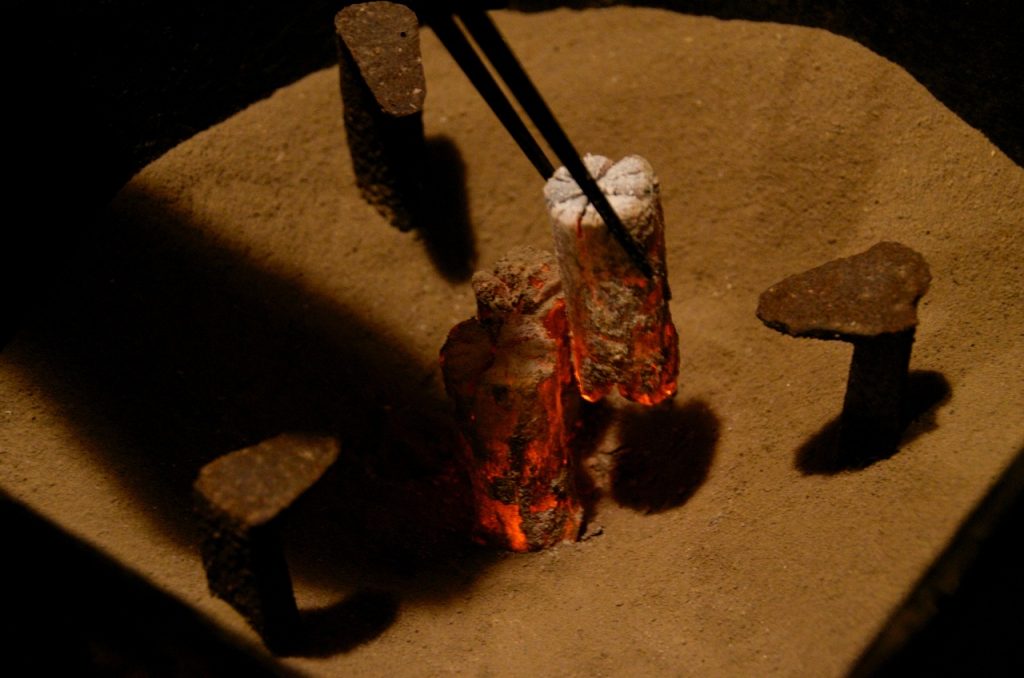
You would serve them a kaiseki-light meal to them. Here there are many variations, you can make a gorgeous multi-course or keep it small.
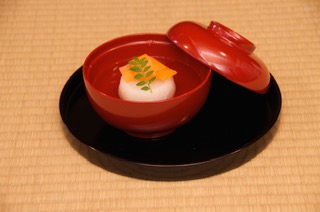
After the meal, you serve your guests two different types of tea together with two different types of sweets.
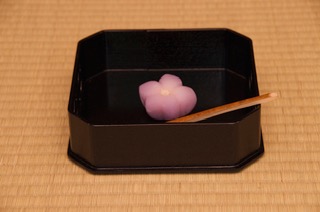

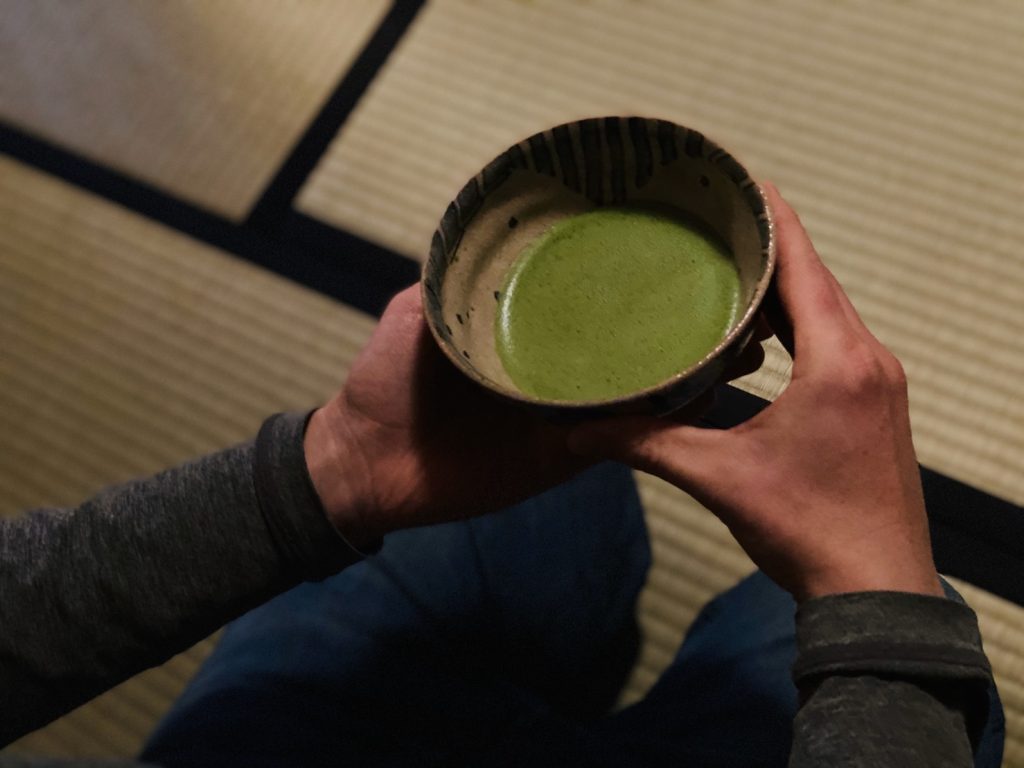
You would invite someone by writing a formal letter in Japanese calligraphy, asking them to join you for a simple bowl of tea, implicitly known to be the koicha-thick tea which is the highlight of the chaji-formal tea gathering. Everything else is considered to be extra. This is why the food is light because the tea is the highlight. When you go to a kaiseki (multi-course meal using freshest seasonal ingredients) restaurant, the kaiseki meal is the highlight and the tea is secondary, if you receive a bowl at all. In Japanese, the two kaiseki are written with different kanji-Japanese characters.
The highlight of the chaji is about this one bowl of koicha-thick tea. The host prepares a bowl of koicha and the guests share (one bowl passed between each guest who takes a sip and passes it along to the next guest) it.
I’m kind of confused because I’ve read tea ceremony also referred to as chado or the way of tea. Are they different or the same? What is the practice of tea for you?
Sōzui: Again, “tea ceremony” is a Western concept that doesn’t exist in Japanese. A formal tea gathering is a chaji and informal ones that are larger public events are referred to as chakai. As I mentioned before, tea practice is like a mountain with many different approaches. You have some who approach tea as a sort of entertainment and are simply satisfied with just going up a little ways, having a bowl and a sweet and going home. Others want to climb all the way to the top. Still others, apply a more Zen approach, where tea is life practice to them.
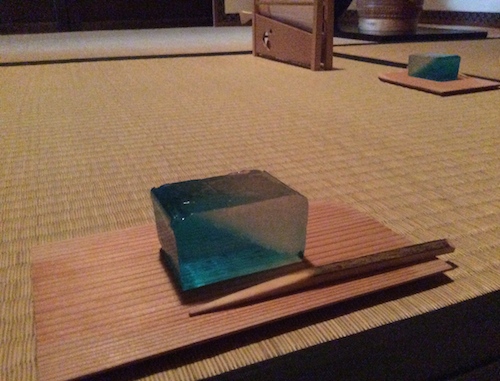
I know Japanese artisans who studied tea to gain insights into how their tea bowls are used or Japanese gardeners who want to better understand the concepts of rock placement and other subtleties underlying Japanese gardens. I find this fascinating because there is something for everyone to discover elements in tea they find interesting and want to study.
For myself, coming from martial arts, originally tea was secondary but over the years it has shifted to almost ninety-eight percent tea practice and only a little bit martial arts. For me, tea has turned into somewhat of a life practice and it never made much sense to study tea and keep everything I learned and experienced just inside the tearoom. So, I always approached tea with the idea of bringing aspects I learned in the tearoom into my daily life.
As you study tea more, you realise it’s a whole universe unto itself with many applications to our life outside of the tearoom. There is a highly regarded tea figure in the Japanese tea world by the name of Sen no Rikyu. He came up with seven main rules of what tea practice should be. I won’t repeat all of them here but one of my favourites is #6, “always expect rain.” Of course, literally it means always carry an umbrella but figuratively, everything that can go wrong, will go wrong at some point, so you have to be ready for that but without forcing it. Simply, try to find the natural flow to get things back on track. This is really something we can take and apply into our daily lives.
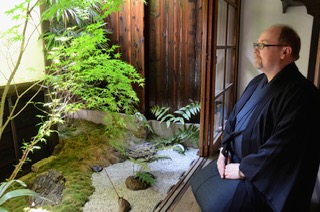
Another rule, in summer create a feeling of coolness and in winter, the feeling of warmth. The tea utensils and set-up of the tearoom would create a cool and fresh feeling but once again, in your daily life you can apply this to relationships. In our relationships we experience moments of coolness and how do we bring back the fire to them. Sometimes things get heated so we need to cool things down. These are some aspects I learned in the tearoom and try to apply to my daily life.
Also, bringing your life into the tearoom happens. After many years of practicing tea, each person starts to bring their own personality into the tearoom and develops their own unique style or approach to their tea practice. It’s not one standard form, it is constantly evolving and your personality adds variety and shapes your practice.
Some people may think Zen or meditation is apart of the tea ceremony. What do you think?
Sōzui: I hear this question a lot. Tea is kind of a moving meditation practice. People always think meditation is sitting quietly in a corner and doing nothing. It may look like they’re doing nothing but this isn’t actually true. Tea is meditation in a different way. Your body is active and you have guests around you, inside the tearoom. The attention is not only on yourself (mindfulness on your centre and breathing), you also must be aware of what’s going on around you.
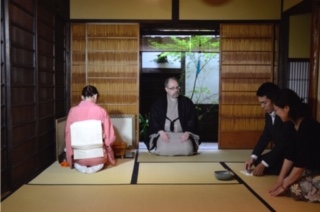
The host makes tea and he’s focused on his own breathing and movements while moving through the procedure. At the same time he must be mindful of the guests, paying attention to every little sip or movement with the bowl and pieces. So, you integrate the presence of your guests into your practice, different to a traditional Zen meditation that’s only focused on yourself. It’s a different approach and style but you can use tea as a kind of moving meditation.
What kind of tea is used and do you have a favourite type of tea? How does one decide what kind of tea is good for them?
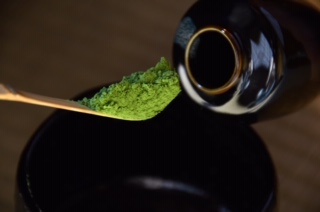
In the traditional Japanese tea ceremony, we use powered green tea-mattcha. I recommend making tea with the best quality of tea available. You can go to any shop in Kyoto and ask for tea ceremony grade tea. They will ask you if it is for thick-koicha or thin-usucha tea and probably give you a few options for each. Just pick one that seems best for you. Basically, you have to be like a wine sommelier and try a lot of different types of tea to find the one you like. Each producer has a number of blends and sometimes you’ll find teas made by collaborations with the heads of tea schools and teashops to make special blends.
It’s difficult to narrow it down to one tea. I have a few favorites and I use these depending on my mood, guests or the occasion. The main question you have to ask yourself. Am I going to drink or serve a thick-koicha or thin-usucha tea? For the thin-usucha teas, I prefer tea that is light and refreshing. They are not as bitter and have a full or rounder taste. It’s more pleasurable to drink and would be comparable to a light summer wine. For the thick-koicha, I’d go for something deep and rich. It’s almost like a paste and will touch your palate completely different. It will have a long finish, similar to an aged bordeaux wine with lots of character.
How does tea have a connection to Japanese martial arts?

Sōzui: Actually, there are many more connections between martial arts and tea than people realize. The way of studying tea for example is the same approach used in martial arts. Basically, it’s a Japanese traditional system of observing your teacher and you try and copy him. The teacher will correct you point by point. You observe your teacher and others and copy the movement, doing the movements over and over again. The same teaching style is applied to both martial arts and tea.
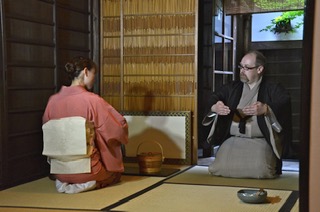
Also, in both the focus point is your centre. Every movement is done with the idea that your centre or belly is kind of a centre of energy and you’re trying to tap into this to incorporate it into your movements in tea, martial arts and other Japanese traditional arts practice. You could say, it’s similar to climbing a mountain. There are different approaches but in the end you are climbing the same mountain.
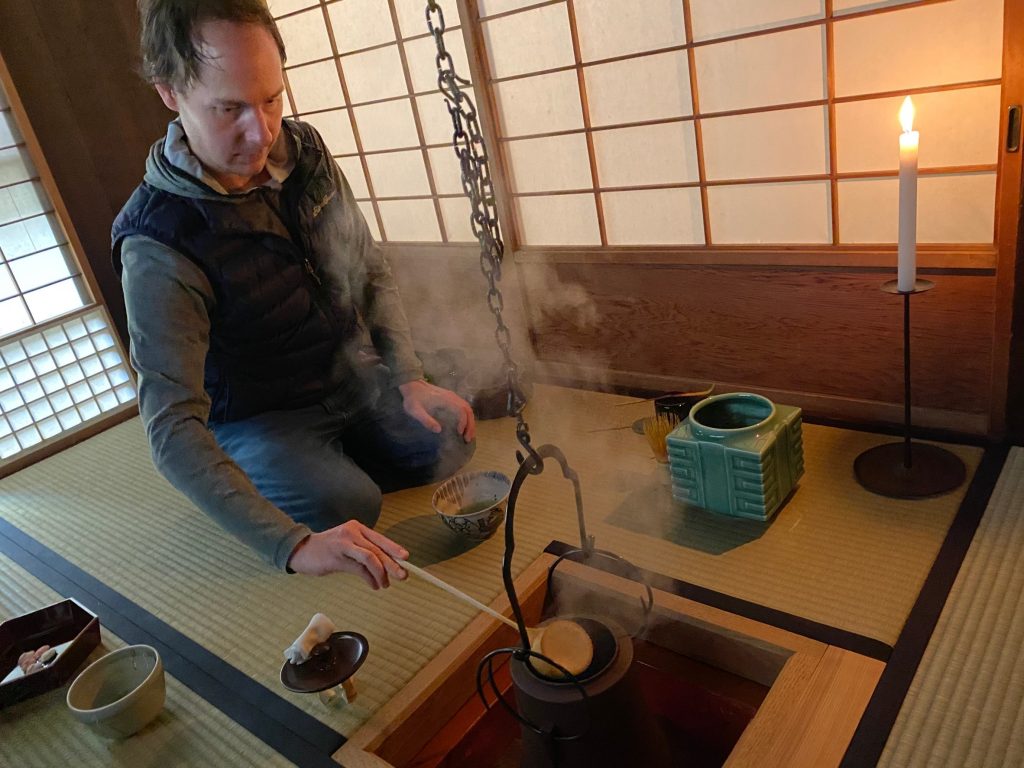
For example in tea, when you handle the ladle (used to pour/scoop water) with the furo-brazier (used to heat the water) the movements are taken directly from kyudo-Japanese archery. At various points in handling the ladle, you’ll see the movements are the same as the holding or release of an arrow. Japanese archers who see the handling of the ladle, would immediately recognize that movement, illustrating one example of the crossover between martial arts and tea. Interestingly enough, many famous samurai in their later years started to practice tea, calligraphy and other arts. At first glance, it might seem awkward to hear martial arts being practiced alongside other cultural arts, but this was a tradition practiced in samurai ranks over many centuries.
If we compare tea and martial arts side by side, the focus on your awareness of self and your surroundings in both situations is the same. When you are attacked by multiple people in aikido, you use the techniques you’ve learned to fight off the first attacker, but at the same time, you must be aware of other attackers too. You have a sense of control over what’s directly in front of you but you also have a sense of what’s going on in the background with the second, third and fourth attackers. I’m aware of how the dynamic in the room changes when I throw the first attacker. Where do I have space to move? Can I throw the first attacker between me and the second to give me more space and time?
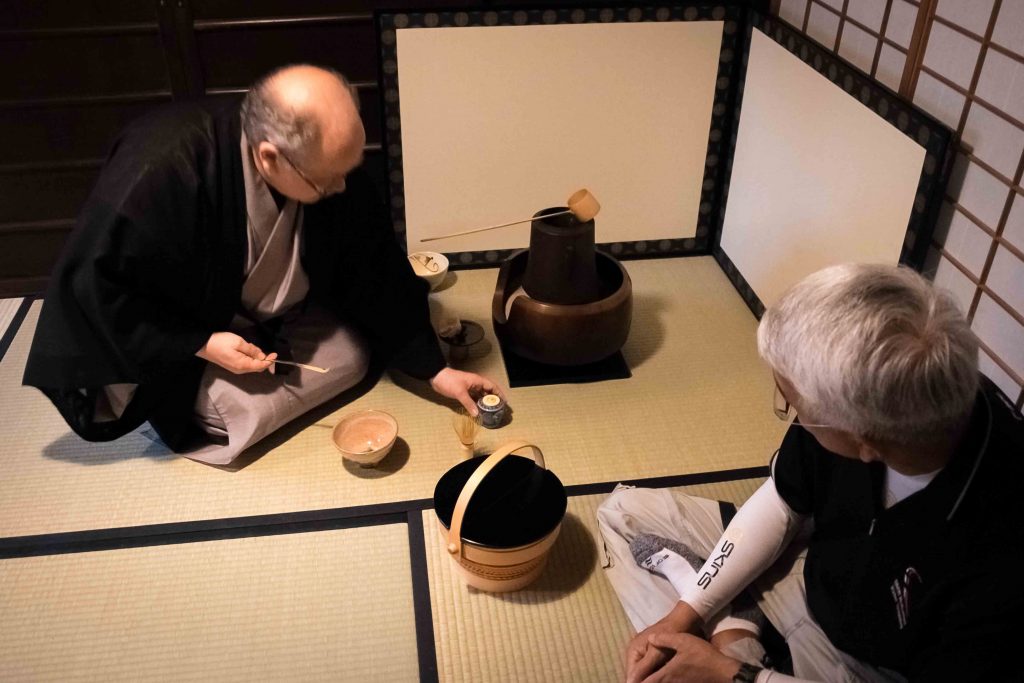
This can be applied to tea as well. When you make a bowl of tea, you are focused on what’s directly in front of you and try to make a perfect bowl of tea for that guest. At the same time, you have more than one guest and you think about who will be next to drink. If someone asks me a question, I’m not a robot just focused on making tea. I have to constantly be aware of aspects in the room that are changing. Is the fire okay? Are my guests enjoying the tea I’m making? This attention to one point in front of you but at the same time being able to keep your mind open to the other things going on around you. This is an important aspect, present in both martial arts and tea practice.
Are there any aspects of tea you’ve brought into your daily life?
Sōzui: It’s difficult to say because you don’t necessarily see it in yourself, especially over the years. Having said that, the way you touch things is probably the most noticeable point that changes after you begin practicing tea. In tea you touch everything with care and show your respect because you could be holding an eight hundred year old tea bowl and don’t want to break it. At the same time, I find you start to handle even the cheapest bowl delicately and treat it the same way you would an expensive piece.
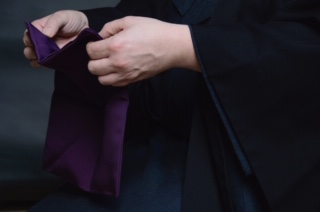
Gradually, this translates over into your daily life. While it might be difficult to notice this point in my own life, I saw the change in my son. Before he started to practice tea with me, he would wash dishes at home and bang the hell out of them but after starting his practice, the way he washed the dishes changed. He’s much more careful in handling them and some of the points I taught him in tea, I see him using those same techniques when he handles the dishes. We have a lot less broken pieces now!!! Haha…
In the tearoom you are also surrounded by a lot of interesting and beautiful pieces. You start to notice the natural beauty around you and appreciate things on a deeper level. It’s almost like an education in art as well that translates into your daily life without you even noticing it.
How long have you been practicing tea for? What is involved in becoming a tea master? Why did you decide to become one?
Sōzui: I started tea in 1989 and martial arts in 1974. The years go by very fast… Honestly, I didn’t have a goal of becoming a tea master. I simply came to Japan to continue my tea studies and I hesitate to call myself a tea master. I always thought it was a bit weird for someone to call them-self a tea master. If other people naturally call you a master or teacher, then accept it gracefully. But calling yourself a master, I don’t think is appropriate.
What I try to do is be chajin or tea person. I try to integrate what I’ve learned and live tea as much tea as much as I can. Similar to the notion of “tea ceremony,” the word “tea master” doesn’t actually exist in Japanese tea. However, the position of tea teacher exists and this is referred to as someone who has received their chamei or tea name. I received mine from the head of my tea school-Urasenke. With this you receive permission to wear a special jittoku jacket and put the crest of the school on your kimono. It’s kind of like clan colours. In a sense, you’ve been adopted into the clan and you now have special permission to represent it.
Many people’s image is a beautiful kimono clad Japanese woman making tea but are there many male tea masters?
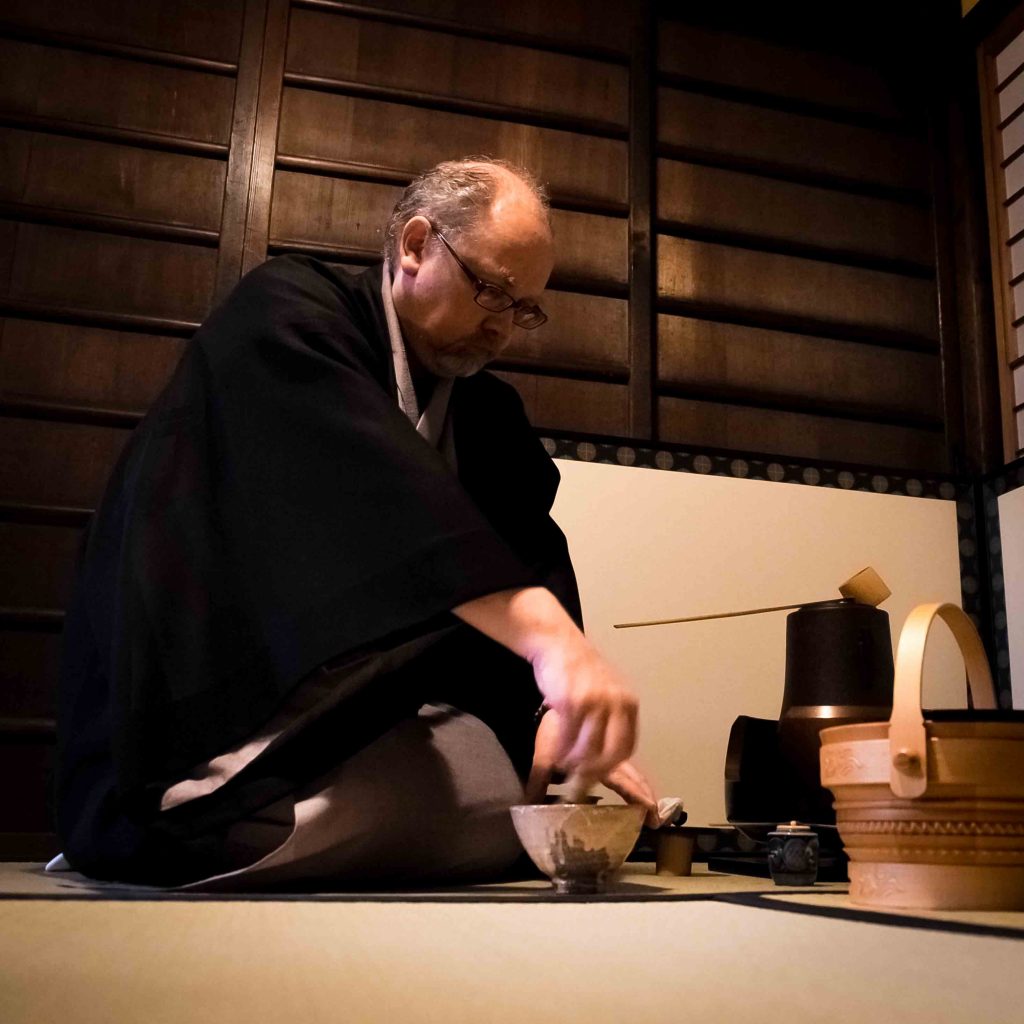
Sōzui: I hear this a lot from guests when they visit. “I thought it would be an kimono-clad Japanese woman making tea.” “Yeah, sorry to disappoint you, just a guy from Switzerland.”
Actually, right now I think about 80 percent of tea people are women but when you look back in Japanese history, it’s relatively new. Until the end of the Edo period (1600-1868), tea was dominated by men. The patrons of tea schools were mainly samurai but after the Meiji revolution, the samurai class was abolished and the schools lost their support. So, the tea schools started to teach tea in girls’ schools and tea actually ended up being taught to young girls as a sort of bridal preparation. Ever since then, the number of male practitioners drastically dropped and number of women greatly increased until today. Having said that, the heads of all the major tea schools are still men.
It seems difficult to find places to practice tea and hold tea ceremonies. What was involved to set up your current tea house-Kanjoan?
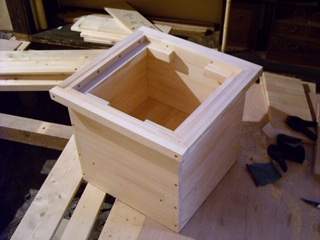
Sōzui: I was fortunate to find an old machiya-town house in Kyoto that felt like a teahouse to me because it’s one floor. This is a bit unusual because most houses are two floors but I turned it into Kanjoan-my current teahouse. It has a nice balance between the front and back gardens. There were quite a few small changes I had to make. I had to install a ro or sunken hearth into the floor and a special ceiling for my smaller tearoom. My wife and I did everything ourselves with the exception of the walls and it took us about two and a half years.
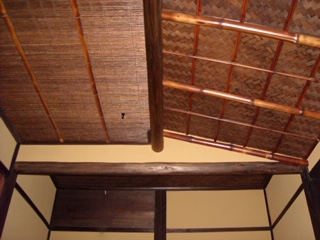
I set up the house with a very traditional teahouse in mind but actually you don’t need such an elaborate setup. I happened to enjoy the process of renovating an old house and turning it into a teahouse. However, it’s possible to have a gathering almost anywhere. Even in your own living room if you wanted. The main point is to make tea and share that bowl with your guests. With the proper knowledge and insights, your surroundings can be transformed into a space for tea.
What do you like most about chado?
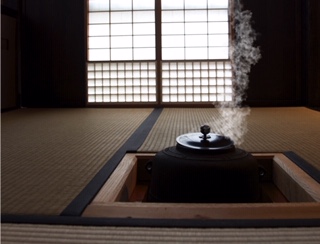
Sōzui: I don’t know, there are so many elements coming together that it’s difficult to pinpoint one specific thing. What I really like though is the intensity and intimacy only a small tearoom can create. You just have a host and maximum of five guests sitting together in the tearoom. You’re all very close and share quite an intensive moment. I’ve actually had a few instances when people cried because they felt so close and able to open up. A lot of emotions can bubble to the top because the tearoom kind of creates a feeling of warmth, safety or comfort to share things.

There is a fire in the middle of the tearoom. The host and guests all sit around it. Fire goes back to the beginnings of human history. Historically, groups of people huddled around fires for heat, protection and to cook. This is something fundamental to all cultures around the world and deeply embedded into our DNA and probably why tea can be understood by people from around the world. We all immediately respond to sitting around a fire in an intimate setting. This is the most beautiful point of tea for me. Even though tea has become uniquely Japanese in some respects, I believe this aspect is what allows it to transcend cultures and borders.
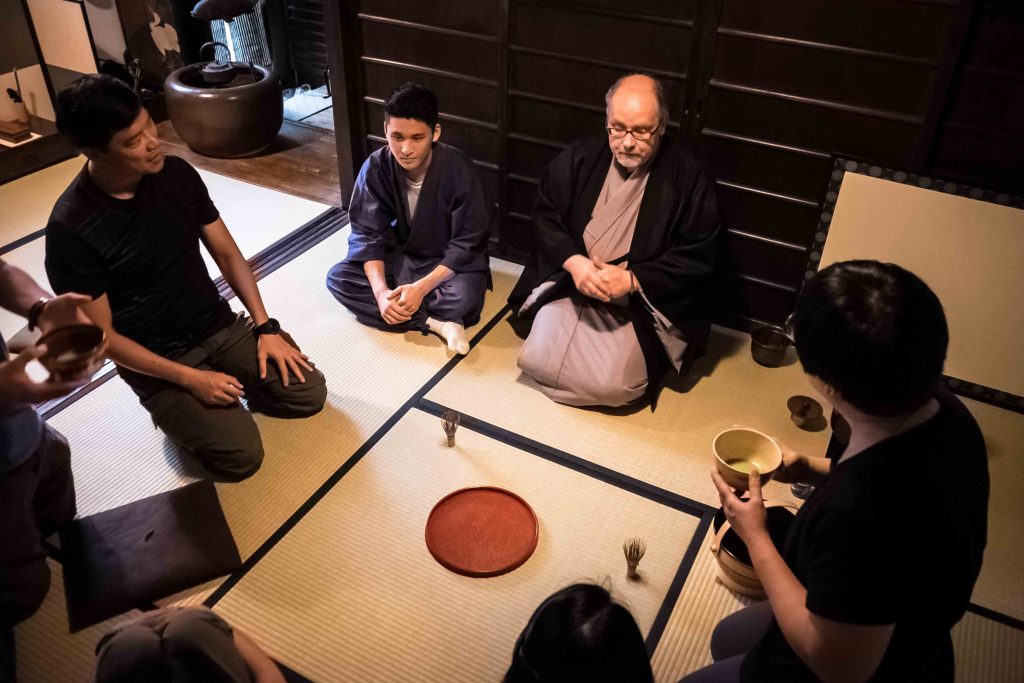
If someone wanted to start practicing tea or check out one of your sessions what should they do?
Check out my website Kanjoan. I offer tea classes for those interested in studying tea and for those simply interested in experiencing tea as a guest. If you want to take a lesson as a student, the first time is free. I recommend going around to different places and talking to students and teachers to find the right place for you.
Think of me like your local friend who happens to be a professional guide. Originally from Canada, I’ve lived in Kyoto for the past 18 years, plus worked at one of the best hotels in Kyoto for 2 years. Through my interviews with locals, I hope you get a feel for Kyoto by listening to their unique stories.
If you’re interested in tours or struggling to plan your trip to Kyoto, I offer tours and/or personalised trip consultations for Kyoto and beyond. Check out my website Hands On Kyoto. I can’t wait to help you discover the hidden side of Kyoto!